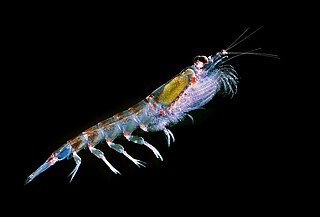
Antarctic krill is a species of krill found in the Antarctic waters of the Southern Ocean. It is a small, swimming crustacean that lives in large schools, called swarms, sometimes reaching densities of 10,000–30,000 individual animals per cubic metre. It feeds directly on minute phytoplankton, thereby using the primary production energy that the phytoplankton originally derived from the sun in order to sustain their pelagic life cycle. It grows to a length of 6 centimetres (2.4 in), weighs up to 2 grams (0.071 oz), and can live for up to six years. It is a key species in the Antarctic ecosystem and in terms of biomass, is one of the most abundant animal species on the planet – approximately 500 million metric tons.

Locusts are various species of short-horned grasshoppers in the family Acrididae that have a swarming phase. These insects are usually solitary, but under certain circumstances they become more abundant and change their behaviour and habits, becoming gregarious. No taxonomic distinction is made between locust and grasshopper species; the basis for the definition is whether a species forms swarms under intermittently suitable conditions; this has evolved independently in multiple lineages, comprising at least 18 genera in 5 different subfamilies.

Swarm behaviour, or swarming, is a collective behaviour exhibited by entities, particularly animals, of similar size which aggregate together, perhaps milling about the same spot or perhaps moving en masse or migrating in some direction. It is a highly interdisciplinary topic.

Krill(Euphausiids) are small and exclusively marine crustaceans of the order Euphausiacea, found in all the world's oceans. The name "krill" comes from the Norwegian word krill, meaning "small fry of fish", which is also often attributed to species of fish.
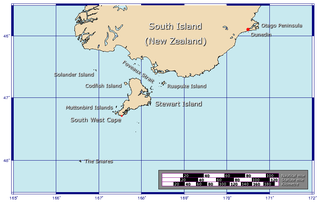
Foveaux Strait is a strait that separates Stewart Island from the South Island of New Zealand. The width of the strait ranges from about 23 to 53 km, and the depth varies between 18 and 46 m. The strait was first charted by an American sealer, Owen Folger Smith. He charted the strait from a whaleboat of the sealing brig Union in 1804.

The desert locust is a species of locust, a periodically swarming, short-horned grasshopper in the family Acrididae. They are found primarily in the deserts and dry areas of northern and eastern Africa, Arabia, and southwest Asia. During population surge years, they may extend north into parts of Southern Europe, south into Eastern Africa, and east in northern India. The desert locust shows periodic changes in its body form and can change in response to environmental conditions, over several generations, from a solitary, shorter-winged, highly fecund, non-migratory form to a gregarious, long-winged, and migratory phase in which they may travel long distances into new areas. In some years, they may thus form locust plagues, invading new areas, where they may consume all vegetation including crops, and at other times, they may live unnoticed in small numbers.

Squat lobsters are dorsoventrally flattened crustaceans with long tails held curled beneath the cephalothorax. They are found in the two superfamilies Galatheoidea and Chirostyloidea, which form part of the decapod infraorder Anomura, alongside groups including the hermit crabs and mole crabs. They are distributed worldwide in the oceans, and occur from near the surface to deep sea hydrothermal vents, with one species occupying caves above sea level. More than 900 species have been described, in around 60 genera. Some species form dense aggregations, either on the sea floor or in the water column, and a small number are commercially fished.
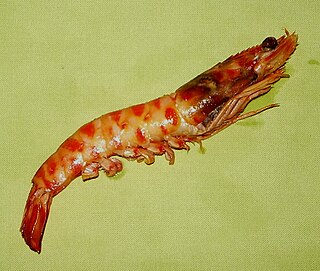
Langosta is a Spanish word with different meanings in different areas, most commonly applied to various types of crustacean. In the United States, it is commonly used in the restaurant trade to refer to the meat of the squat lobster, which is neither a true lobster nor a prawn. Squat lobsters are more closely related to porcelain and hermit crabs. Crustaceans labeled as langostino are no more than 8 cm (3 in) long, and weigh no more than 200 g (7 oz). Langostinos are not langoustes despite a similar name. Also, langostinos are sometimes confused with langoustines.
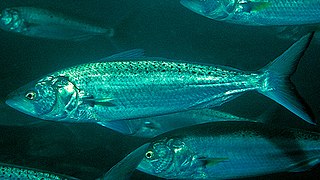
Arripis trutta, known as the Australian salmon in Australia and as kahawai in New Zealand, is a South Pacific marine fish and one of the four extant species within the genus Arripis, native to the cooler waters around the southeastern Australian coasts and the New Zealand coastline. Other common names for this species include Eastern Australian salmon, bay trout, blackback salmon, buck salmon, cocky salmon, colonial salmon, newfish and salmon trout.

The narrowmouthed catshark is a catshark of the family Scyliorhinidae, found from central Chile around the Straits of Magellan, to Argentina between latitudes 23° S and 56° S, at depths down to about 180 m (600 ft) in the Atlantic Ocean and about 360 m (1,200 ft) in the Pacific. It can grow to a length of up to 70 cm (28 in). The reproduction of this catshark is oviparous.

Enteroctopus megalocyathus, also known as Patagonian red octopus (EN), Pulpo del sur (Chile) and Pulpo colorado (Argentina); is a medium-sized octopus, and the type species for the genus Enteroctopus.

Munida is the largest genus of squat lobsters in the family Munididae, with over 240 species.
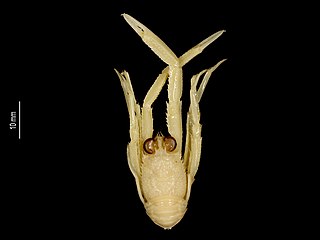
Plesionida is a genus of squat lobsters in the family Munididae. As of 2017, it contains the following species:

Paranotothenia magellanica, also known as Magellanic rockcod, Maori cod, blue notothenia or orange throat notothen, is a species of marine ray-finned fish, belonging to the family Nototheniidae, the notothens or cod icefishes. It is native to the Southern Ocean. "Maori chief" and "black cod", sometimes used for this species, usually refer to fishes from the related genus Notothenia. Being a perciform fish, it is unrelated to the true cods of the order Gadiformes. This species is commercially important as a food fish.

Munida rugosa, commonly known as the rugose squat lobster or plated lobster, is a species of decapod crustacean found in the north east Atlantic Ocean and the Mediterranean Sea.

Panulirus ornatus is a large spiny lobster with 11 larval stages.

Scolonida gracilis is a species of squat lobster in the family Munididae.
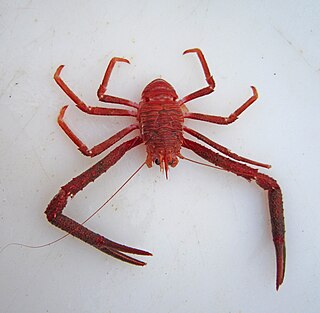
Munida quadrispina is a species of squat lobster. It was originally introduced to science by James E. Benedict in 1902. This and other species of squat lobsters are sometimes referred to as "pinch bugs".
Patagonotothen brevicauda, the Patagonian rockcod, is a species of marine ray-finned fish, belonging to the family Nototheniidae, the notothens or cod icefishes. It is native to oceans of the Patagonian region, including Tierra del Fuego, the Strait of Magellan, the Beagle Channel and the Falkland Islands.

Scolonida is a small genus of squat lobsters in the family Munididae. It was erected in 2022 to accommodate three species previously placed in the genus Munida. The genus name combines the Greek scolos (=spine) and the genus name, Munida, and refers to the presence of protogastric spines that characterize the genus.



















